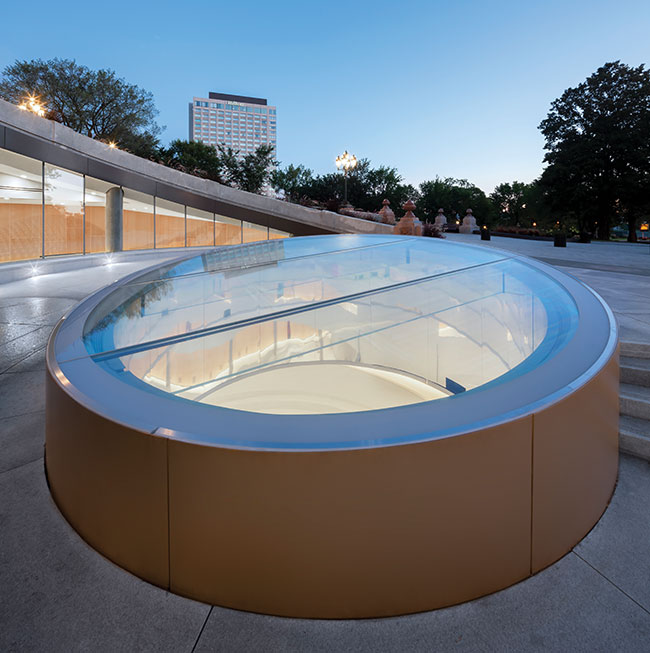
Features
Contracting
Architectural design
Fabrication
The Oculus – Quebec National Assembly
May 1, 2020 By Adam Mitchell

AT A GLANCE – The Oculus
Architect: Provencher Roy and GLCRM Architectes
Glazing contractor: Vitrerie Fortin
Glass fabricator: Agnora
Supports: Five-layer laminated 0.5-inch Optiwhite by Pilkington combined with SentryGlas interlayer – total thickness 2 5/8 inches
Exterior glass: Three layers of 12-millimeter Saint-Gobain
Cool-Lite 7033 and one two-layer, six-millimeter variant
The reception pavilion of Quebec’s National Assembly was due for a modernization and re-imagining in order to create a fantastic, bold centrepiece that engages visitors’ senses and serves as a learning space. Designed by leading architects Provencher Roy and Gagnon Letellier Cyr Richard Mathieu et Associes Architectes (GLCRM Architectes), the reception building was built underground, separate from the Parliament Buildings in an effort to define the modern reception space while maintaining visibility to the unique exterior façade of the heritage site. Connected seamlessly to the front door via elevator, visitors are shuttled to the marvelous underground space in which they can fully experience the gravity of the legislature tower through one of the pavilions defining features: the Oculus.
The Oculus has an overall diameter of 191 inches and is supported by two highly complex five-piece laminates that hold over 7,500 pounds of precision CNC-radiused laminates.
The resulting installation can be described as a work of art. Polished, clear and impeccably fabricated, the Oculus is the centrepiece to this wonderous underground experience, casting brilliant natural light across its floor and creating an area of intrigue.
The Oculus was a highly complex project to fabricate, James Cole, project manager at Agnora, states. “This was one of the most technically difficult jobs I’ve put through fabrication. Our team really knows their stuff and everything was installed without rejection or difficulty, the first time.”
The two horizontal supports had a myriad of custom features and incredible fabrication aspects. The supports for the radiused vision glass were five-layer-laminated half-inch Optiwhite by Pilkington. Combined with a SentryGlas interlayer the total thickness became 2 5/8 inches. The length of the glass was extremely long and narrow, totaling 191 by 16 inches, creating challenging alignments and complicating the tempering processes. A five-degree angle was added to the 191-inch length of each glass support, so each piece of the five-layer had to be individually CNC machined and painstakingly aligned in the lamination process to create a perfectly flush, five-layer, 191-inch, five-degree edge. As this was an exposed edge, all sides were fully polished. Every support was engineered with a notch to allow it to be placed along the structural support of the building.
The exterior insulating glass units included a total of three radiused pieces with the outboard lite being three-layers of 12-mm OptiWhite and the inboard lite made of Saint-Gobain Cool-Lite 70/33 on six-mm Diamant and one layer of six-mm OptiWhite. All glass was laminated with SentryGlas. Boasting an impressive total diameter of 191 inches in total, each of these pieces weighed in at roughly 2,500 pounds. When placed along the supports, the five-degree supports allow for the glass to shed rainwater and maintain a relatively clear surface.
As the perimeter of the Oculus was placed within structural supports, the full perimeter required custom-printed frit to hide unwanted visual features. Agnora’s print team and DipTech printer concocted a custom shade of grey to match perfectly to the surrounding features. This “blended” frit provided a subtle transition from clear to fully opaque glass without outlandish colour differences that would draw the eye and take away from the clarity of the Oculus feature.
Print this page